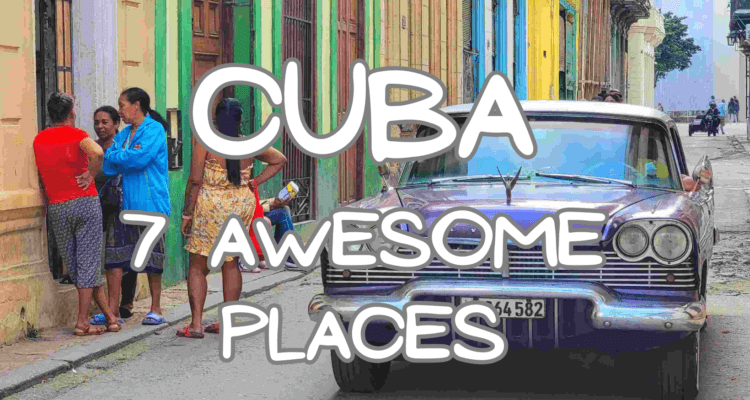Cuba, a captivating island steeped in history, beckons with its sun-kissed beaches, salsa-pulsating streets, and mojitos as vibrant as its culture. Beyond the iconic cigars and vintage Chevys, a tapestry of hidden gems awaits the curious traveler. Buckle up, because we are taking you on a journey to seven dazzling and surprising corners of the island that will leave you breathless and begging for more.
Most travelers come to Cuba for one of it’s 430 beaches along a 5600 km coastline. And we get it, the beaches are quite pretty. However the limitations of this country, given how it is ruled, cause way too many restrictions for us to enjoy these beaches over say the ones in nearby Antigua. In addition, most of the dry season in Cuba, the water temperature is quite cool compared to some of it’s more southern Caribbean islands.

The authentic soul of the island lies beyond the tourist havens, pulsating in the live son cubano music spilling from cafes, the laughter echoing through cobbled streets, and the stories whispered by weathered colonial facades and it’s inhabitants. Forget predictable package tours and join us on an exploration of the real Cuba, where hidden gems like, Topes de Collantes Natural Park, Viñales Valley’s emerald tapestry and Cienfuegos’ flair await.
We’ll share local secrets, essential tips, and immersive experiences that unlock the heart of this captivating island. Brace yourself to trade sun lounger bliss for cultural immersion, because the real Cuba is an adventure waiting to be discovered.
1. Trinidad: A Technicolor Dream in Time

Step into Trinidad, and you’ve tumbled into a Technicolor dream. Cobblestone streets, awash in hues of ochre, coral, and cerulean, snake between pastel-perfect plazas adorned with wrought-iron balconies overflowing with vibrant blooms. Since this city was founded in 1514, every corner is a postcard, every doorway a promise of intrigue. The air thrums with the infectious rhythm of live son cubano music, spilling from sun-drenched cafes and echoing through the labyrinthine alleyways.
Trinidad’s magic lies not just in its beauty, but in its soul. This UNESCO World Heritage gem is a living museum, its colonial architecture whispering tales of sugar barons and pirates, slaves and revolutionaries. Climb the bell tower of the Iglesia Mayor de la Santisima Trinidad for panoramic vistas, or get lost in the amazing Palacio Cantero with even more spectacular vistas and a treasure trove of antiques. At dusk, sip mojitos on the rooftop of Munoz Tapas, a legendary bar where time seems to stand still.
PRO TIP: On the hilltop, just behind the Hotel Mystique is the Disco Ayala which is located in an underground cave. We went hiking during the day and stumbled on this hidden treasure. The guard let us in and we were able to enjoy the coolness of these caverns with no one else in -site.
Trinidad – Where to Stay

This is one of those towns where wherever you look you see beauty and history. Although there are a few 5-star hotels, we sure can’t recommend them as Cuba’s 5 star levels are not what we as foreigners are used to. And the money goes to the government – not the people.
There are plenty of fantastic Casa Particulars in this town as well as other parts of the country that are very much worth the stay. And the money goes to the people, not the government.
For example, we stayed in a 3 bedroom private house, with 3 bathrooms, an elegant living room with a huge and gorgeous rooftop terrace (with a wood burning pizza oven) and our own washer to boot. All of this was for about $60 USD per night. And we were just off of the main plaza of Plaza Carillo where it was quiet.
PRO TIP: If you want to be in a quiet place, make sure that you are not located next door to a main plaza or a bar with live music. Therefore a street or 2 off of the main plazas is the best spot as you are close enough to the action, but far enough from the noise. And believe me, the noise can get really loud here if you do not pre-plan and ask your Casa Particular host if there are any predictable offenders around the premises.
Trinidad – Where to Eat
Wow, Rob was in heaven here! He was dining on lobster every night and sometimes even during lunchtime. Here are some of the restaurants that we can highly recommend:
- Cafe Garaje: For a lunch, a light dinner or a snack this is a super cute little place for some local food. Incredibly inexpensive prices and quality food (albeit no lobster). And in addition, the drinks are quite pretty and fancy.
- Restaurant El Dorado: An elegant restaurant with very reasonable prices for lobster, fresh fish and other Cuban delicacies.
- Obbatala: One of our favorites in Trinidad is this elegant rooftop restaurant that serves lobster and fresh fish from the grill. The view overlooks Plaza Mayor.
PRO TIPS DINING:
All of the restaurants that we recommended are priced in CUP (Cuban currency), making the meal much more reasonable. That is to say that you exchanged your foreign currency to CUP on the black market and received the better rate. At time of writing the USD to CUP (black market rate was around 270). So we highly recommend that whatever restaurant you choose to visit, make sure that you check the CUP prices and do some comparison shopping in the local currency.
For me, the vegan restaurants in Trinidad were just not worth the money, so we cannot recommend them. However, in almost every cafe, they were happy to make me something. Some of the options that I was given were: roasted vegetables with rice or pasta with vegetables and tomato sauce. They were always happy to accommodate. A quick question, ¿Tienes algo o puedes hacerme algo que sea vegano?”, usually does the trick.
2. Topes de Collantes Natural Park
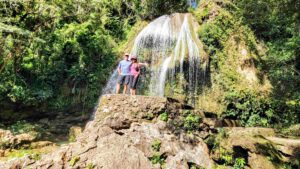
To leave, Trinidad is a difficult proposition as the place is amazing. However, if you are ready to escape the sun-drenched streets and immerse yourself in the verdant paradise of Topes de Collantes Natural Park we can totally understand! Topes de Collantes National Park can be a day trip teeming with natural wonders and breathtaking vistas. This mountain range, just 12 km from Trinidad, offers a refreshing change of pace and a chance to explore Cuba’s diverse ecosystem.
Start your day by hiring a private 4X4 taxi or joining a guided tour from Trinidad or Cienfuegos. The scenic journey takes you through rolling hills blanketed in lush greenery, offering glimpses of traditional Cuban villages along the way. As you ascend, the temperature drops, providing a welcome respite from the tropical heat.

Your first stop could be through coffee plantations and farmer’s homes to El Salto del Caburní, a cascading waterfall surrounded by lush vegetation. Take a refreshing dip in its natural pool, hike on the scenic trail leading up to the falls, or simply admire the power and beauty of the water thundering down the rocks.
For lunch, opt for a rustic “paladar” in a nearby village, savoring authentic Cuban dishes like “ropa vieja” (shredded beef) or “pescado a la plancha” (grilled fish). Refueled, explore the diverse trails crisscrossing the park. Hike to the viewpoint at Loma de la Cruz for panoramic views of the valley below, or venture deeper into the forest to discover hidden waterfalls like Salto de Javira or El Nicho.
With its abundance of hiking trails, cascading waterfalls, and stunning natural beauty, Topes de Collantes offers an unforgettable day trip from Trinidad. Remember to bring comfortable shoes that have some grip and can get wet, a bathing suit and a towel, water, some snacks, sunscreen, insect repellent, and your sense of adventure!
PRO TIP:
To get to Topes de Collantes Natural Park, you will need a 4X4 vehicle, so don’t be fooled by taxi drivers in Trinidad or Cienfuegos that try to talk you into a 2 wheel drive vehicle.
One can spend days here, hiking various trails and peaks and swimming in all the waterholes the park provides. For this, you will need to coordinate with one of the guides that truly knows the area and can coordinate camping or some farm stays there.
If you are interested in finding out more about extended stays in the park, please ping us in the comments and we will provide some names of fantastic guides that we interacted with.
3. Viñales Valley: Where Tobacco Meets Jurassic Majesty

Viñales Valley is a landscape ripped straight from a Jurassic fantasy. Towering mogotes, limestone giants weathered into fantastical shapes, pierce the emerald-green tapestry of tobacco fields. Farmers till the land with oxen carts, their rhythmic chants echoing through the valley. The air hangs heavy with the earthy scent of tobacco leaves, promising the full-bodied pleasure of a Cuban cigar.
Hike among the mogotes, their weathered surfaces offering breathtaking panoramas of the valley below. Explore the Cueva del Indio, a natural cavern adorned with prehistoric pictographs, or saddle up for a horseback ride through tobacco fields, learning the secrets of this prized leaf from local farmers.
In the heart of the valley lies Viñales town, a charming collection of pastel houses and lively cafes, where time seems to slow to the rhythm of swaying palm trees and clinking glasses. End your day with a sunset atop Hotel Los Jazmines, watching the sky ignite in a kaleidoscope of colors as the valley below surrenders to the night.
Viñales Valley: Finca Agroecológica El Paraiso
The reason to travel to Vinales Valley is to experience the countryside, the tobacco fields and taste some amazing organic farm to table foods. There are a few tobacco estates (fincas) here that offer just this. However, our favorite one was the Finca Agroecológica El Paraiso.
Here we were taken on a hike to experience the tobacco and coffee bean fields, squeezed our bodies through an amazing secret cave and ate a delicious organic farm to table meal. In addition, we were shown how to roll our own cigars while Rob also enjoyed some special rum.
PRO TIP: This Finca is incredibly popular, so try to come either prior to 12:00 pm or after 3:00 pm to enjoy it’s tranquility and beauty without the crowd.
4. Soroa: A Nature Lover’s Paradise

Found amidst lush mountains and cascading waterfalls, Soroa is an eco-lover’s paradise. This biosphere reserve teems with endemic flora and fauna, making it a haven for birdwatchers and nature enthusiasts alike. We spent hours hiking the different trails of Soroa.
The Mirador Loma el Mogote trail is a must as it takes you up to the highest vista of Soroa. We hiked up an established trail, through verdant forests alive with the cacophony of tropical birds. After the hike, a dip in the emerald waters of El Salto de Soroa, a natural waterfall is quite refreshing!
The Orchid Garden is also a must visit spot located in the same area of Soroa. There, you will be taken on a guided tour of the gardens which includes different trees, plants and many varieties of orchids. It is a peaceful and beautiful spot which overlooks the park.
There are a few small B&B’s in these parts, but we pushed on to the city of Soroa for dinner and our hotel.
PRO TIP: All of these attractions can be reached from one parking lot found here. Bring some CUP with you as each one of these attractions charges a nominal fee.
5. Las Terrazas: Art + Nature in Cuba
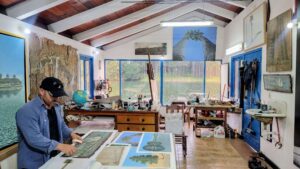
Las Terrazas is a verdant tapestry woven into the Sierra del Rosario Biosphere Reserve (a UNESCO project). This community was borne out of a reforestation project in the 1970s. This place is pure art seamlessly blended with nature and community set to the rhythmic beat of Cuban music.
Here, waterfalls cascade through vibrant rain-forests and hidden trails beckon exploration. Hike the Sendero El Contento, its path tracing the footsteps of escaped slaves and revealing remnants of old coffee plantations. Unwind at the Baños de San Juan, natural rock pools fed by crystal-clear waters.
Beyond the natural wonders, Las Terrazas thrums with artistic expression. Explore the Galeria de Lester Campa, where engaging landscapes unfold on canvas, or lose yourself in the whimsical sculptures crafted from recycled materials by Ariel Gato. Engage with local artisans as they demonstrate their craft, witnessing the cultural vibrancy woven into the fabric of the community.
And don’t miss Casa de Polo Montañez, the former lakeside house of the iconic Cuban singer. Now a small museum, it offers a glimpse into his life and musical legacy, with gold records and memorabilia whispering tales of the man whose soulful voice captured the nation’s heart.
Las Terrazas – Where to Eat
- El Romero: For a plant-based paradise, look no further than El Romero. This eco-conscious haven specializes in delectable vegetarian dishes (which can also be made vegan) crafted with love. Imagine sinking your teeth into a vibrant plate featuring homegrown, organic vegetables, all prepared using sustainable solar energy. Even the honey comes from their very own beehives! To elevate the experience, snag a table on the terrace and savor your meal with breathtaking mountain views as your backdrop.
- La Terraza: Immerse yourself in rustic charm at this open-air restaurant, savoring Cuban classics like ropa vieja (shredded beef) and fresh seafood caught locally. In addition, they do make delicious and organic plant based dishes. I had a plate of amazing roasted vegetables, rice and black beans. This restaurant is a bit difficult to find as it sits on the hill overlooking the lake. Just ask a local.
6. Cienfuegos: The “Pearl of the South”
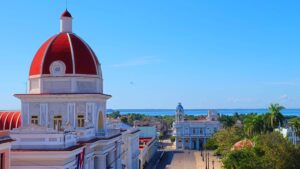
Forget comparisons – Cienfuegos, Cuba’s “Pearl of the South,” shines with its own vibrant identity. This UNESCO World Heritage Site boasts a captivating blend of cultures and eras, evident in its architecture and buzzing streets.
The city was founded by French settlers in the early 19th century, and their legacy lives on in the charming streets and squares. The Ferrer Palace, now a cultural center, is another testament to this French connection. It’s a prime example of neoclassical architecture and offers a glimpse into the city’s past. The Palace is located just off of the José Martí Park and Triumphal Arc, which are also a must see. To orient yourself, get a drink at the rooftop deck of the Hotel La Union.
One can wander the Paseo del Prado, lined with tamarind trees, cafes and shops. The Paseo del Prado runs from the El Inglés River to Punta Gorda , being the longest street of its kind in all of Cuba . Along the Paseo, you can also find a monument to Benny Moré, the renowned “King of Cuban Son”.
Additional things to see here are the rich history at the Museo Provincial, housed in a former palace. Or if you enjoy the arts and souvenirs, immerse yourself in the local spirit at the bustling Mercado de Artesanía teeming with crafts and souvenirs. In addition, the Catedral de la Purísima Concepción, is worth a stop as it is considered a local architectural gem.
The Malecón of Cienfuegos stretches from the Paseo Del Prado to the Punta Gorda area. It is a sea wall which features amazing early 20th century mansions and quite a few upscale restaurants.
On your way down, stop at the Hotel Palacio Azul for a look at the beautiful architecture. The Palacio de Valle, was built by an Italian architect in 1917 (allegedly using mobster money and connections). Today it is an upscale seafood restaurant. The upstairs terrace has great views to the sea and for sunsets.
PRO TIP: If you are landing in Cienfuegos or just passing through from Varadero to Trinidad (as we did) consider spending 3-4 hours here. It is definitely worth the stop.
7. Old Havana: Where History Hums and Mojitos Flow

Havana Vieja, or Old Havana, is Cuba’s heart, a pulsating epicenter of history, culture, and rum-soaked revelry. Baroque facades, adorned with wrought-iron balconies and peeling grandeur, line cobbled streets teeming with life. Classic American cars, in an explosion of chrome and fins, navigate the labyrinthine alleys, their rumble a rhythmic counterpoint to the salsa steps clicking on the sidewalks.
Yes, this is Old Havana. And of course this is not a hidden gem – everyone knows of it’s captivating splendor! Yet, most people come to Cuba solely for the beaches and miss this must-visit town! We spent 6 nights here and still wanted more!

Our favorite aspects of the city were being able to walk everywhere and truly experience the city and it’s nuances. Make sure to dive into the heart of Havana with a visit to the iconic Plaza de la Catedral, where centuries-old churches and grand palaces whisper tales of Spanish conquistadors. In addition, Plaza Vieja and Plaza de Armas are spots to visit in the day and in the night.
Exploring Parque Central and the myriad of antique cars which are on display here is a must. To get a better view of the city, we suggest popping up to the rooftop cafe of the Iberostar Parque Central Hotel. Don’t forget to stop at the El Floridita Bar and/or La Bodeguita del Medio Bar to see where Hemingway spent much of his time while living in this city.
If you have time, consider catching the sunset at the Malecon – it is gorgeous. And above all, make sure to get lost in Old Havana, zigzagging all of it’s nooks and crannies.
Old Havana – Where to Eat
Walking through the streets of this Old Town you will see a variety of eateries and cafe’s. The hard part is to choose the right ones. Here are some of our favorite eateries here. We hope you enjoy them!
- El Shamuskiao: A viby vegan cafe with daily specials and a modest menu. The stuffed eggplant is a must try! Everything was tasty. However, this place is ultra popular and fills up quickly, so either come early or later in the afternoon. The prices are in CUP and it is very reasonable.
- Camino al Sol: This is a vegan/vegetarian cafe that also sells frozen raviolli, pastas and sauce. The vegan ravioli was divine as was the chocolate dessert! We had appetizers, fresh fruit drinks, lattes, 2 main dishes and 2 desserts with 500 gm of ravioli and a huge bottle of vegan pesto sauce to go for $24 USD (in CUP)! Please note this restaurant is located 13 km east of Old Town.
- El Café: Located in the heart of old town serves sandwiches, coffees and cocktails. They even have vegan sandwiches and almond milk for lattes – which are hard to find anywhere in the country!
- Teniente Rey 360: Cuban food and seafood at good prices. They even made me a vegan vegetable rice that was delicious.
- Donde Lis Restaurant: Good atmosphere and food. The prices are in USD, but they are reasonable.
- Café Cuatro Lunas: This is the perfect place for a really special evening with white tablecloths and elegance. We liked it so much, we went back 3 times! The lobster and fish of the day were Rob’s favorites. And with all of this elegance, the price was downright cheap and in CUP.
Old Havana – Where to Stay
We stayed in 2 magnificent Casa Particulars in Havana. Both were amazing! Just depends on where you want to be physically.
- 62 Amargura: This Casa Particular was right on the pedestrian only Amargura Street. The building was recently renovated to it’s gorgeous splendor and we wished we had stayed longer. It is available through AirBnB as well as all of the other venues. We had a two bedroom apartment with a private bathroom, balcony and kitchen for $46/night. The building has a variety of different apartments to choose from with a large garden terrace as well as a roof top one.
- Focsa Building: This apartment building is considered one of the treasures of Havana and is located next door to the famous Hotel Nacional (which is worth a walk through). Our apartment was on the 24th floor and overlooked the whole bay, towering over the Hotel Nacional. Although the kitchen space was a closet (it was workable) and our 2 bedroom, 2 bathroom apartment with incredible views from every window was definitely worth the $50 USD per night.
Wrap Up
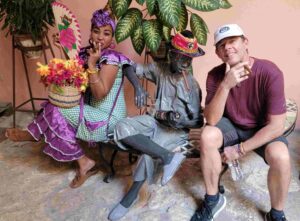
Cuba really surprised us! Although the touristy spots like Varadero did not amaze, the rest of the country sure did. It was the intimate moments spent speaking with our guides who openly shared so much of their lives and the strife of their families and the Cuban people that really resonated with me.
The verdant nature of this country is what drew us in – the mountains and valleys, the farms and waterfalls are incredible. Trinidad’s architecture and vibe made it one of my favorite places in the world (and at time of writing we have been to 177 countries) – so this does say something!
Have you found any hidden gems in Cuba? Or maybe some additional tips and tricks? We would love to hear from you in the comments!

